Strategic Human Resource Management at Sainsbury's: IPRP Analysis
VerifiedAdded on 2023/01/07
|9
|2844
|98
Report
AI Summary
This report provides an evaluation of Individual Performance Related Pay (IPRP) within the context of Sainsbury's, a major UK retailer. The introduction establishes the significance of strategic human resource management and its impact on organizational goals. The main body delves into the evaluation of research related to IPRP, emphasizing its role in motivating employees through salary structures and performance-based incentives. It explores circumstances where IPRP is effective and the specific scenarios that encourage employee motivation within the retail sector. Furthermore, the report examines situations in which IPRP may not yield the desired results, such as issues related to eligibility restrictions and potential demotivation. The analysis covers the importance of employee effort, loyalty, and the role of rewards in sustaining motivation. The conclusion summarizes the key findings, highlighting the importance of human resources and effective strategies in achieving organizational objectives. References to relevant academic research support the analysis.
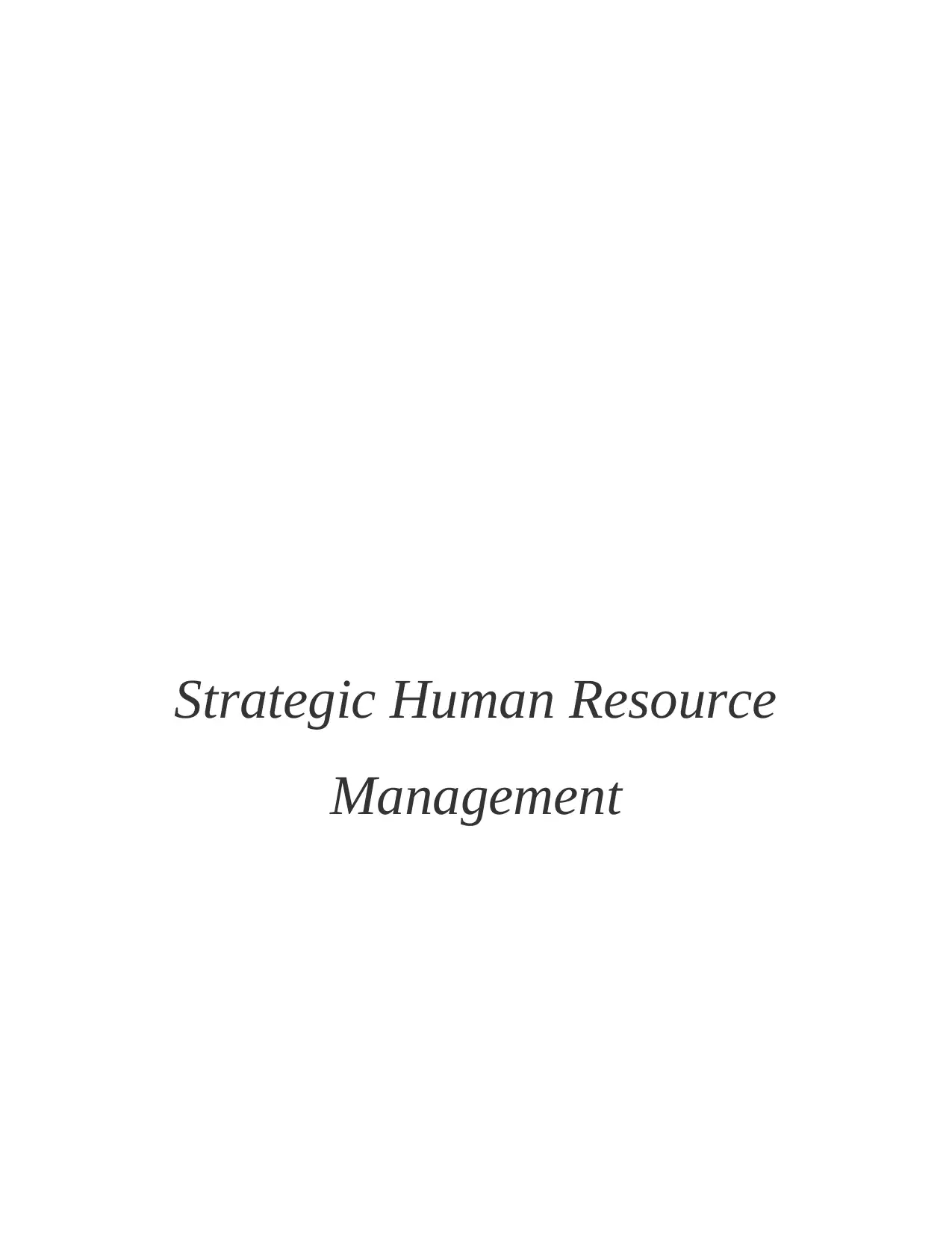
Strategic Human Resource
Management
Management
Paraphrase This Document
Need a fresh take? Get an instant paraphrase of this document with our AI Paraphraser
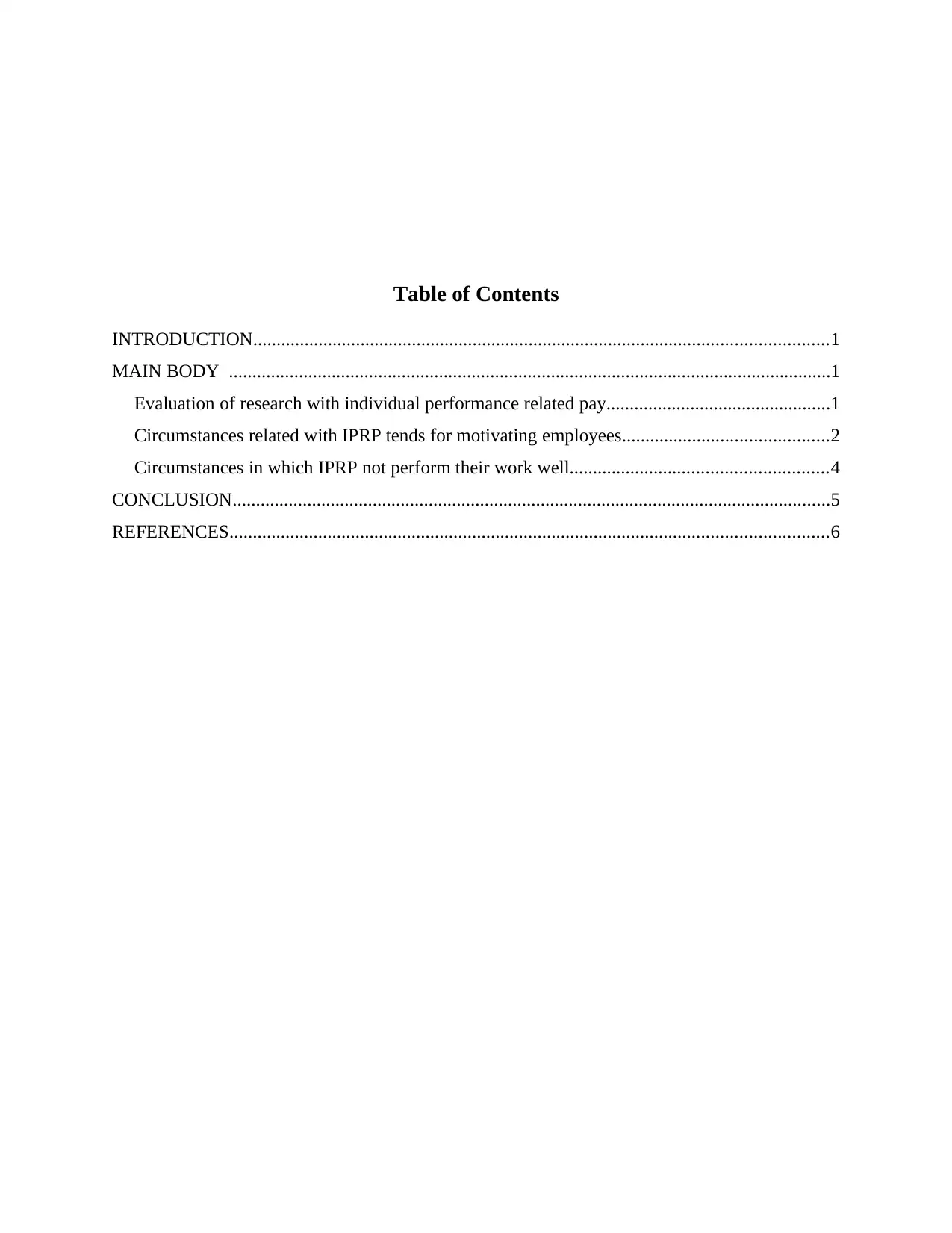
Table of Contents
INTRODUCTION...........................................................................................................................1
MAIN BODY .................................................................................................................................1
Evaluation of research with individual performance related pay................................................1
Circumstances related with IPRP tends for motivating employees............................................2
Circumstances in which IPRP not perform their work well.......................................................4
CONCLUSION................................................................................................................................5
REFERENCES................................................................................................................................6
INTRODUCTION...........................................................................................................................1
MAIN BODY .................................................................................................................................1
Evaluation of research with individual performance related pay................................................1
Circumstances related with IPRP tends for motivating employees............................................2
Circumstances in which IPRP not perform their work well.......................................................4
CONCLUSION................................................................................................................................5
REFERENCES................................................................................................................................6
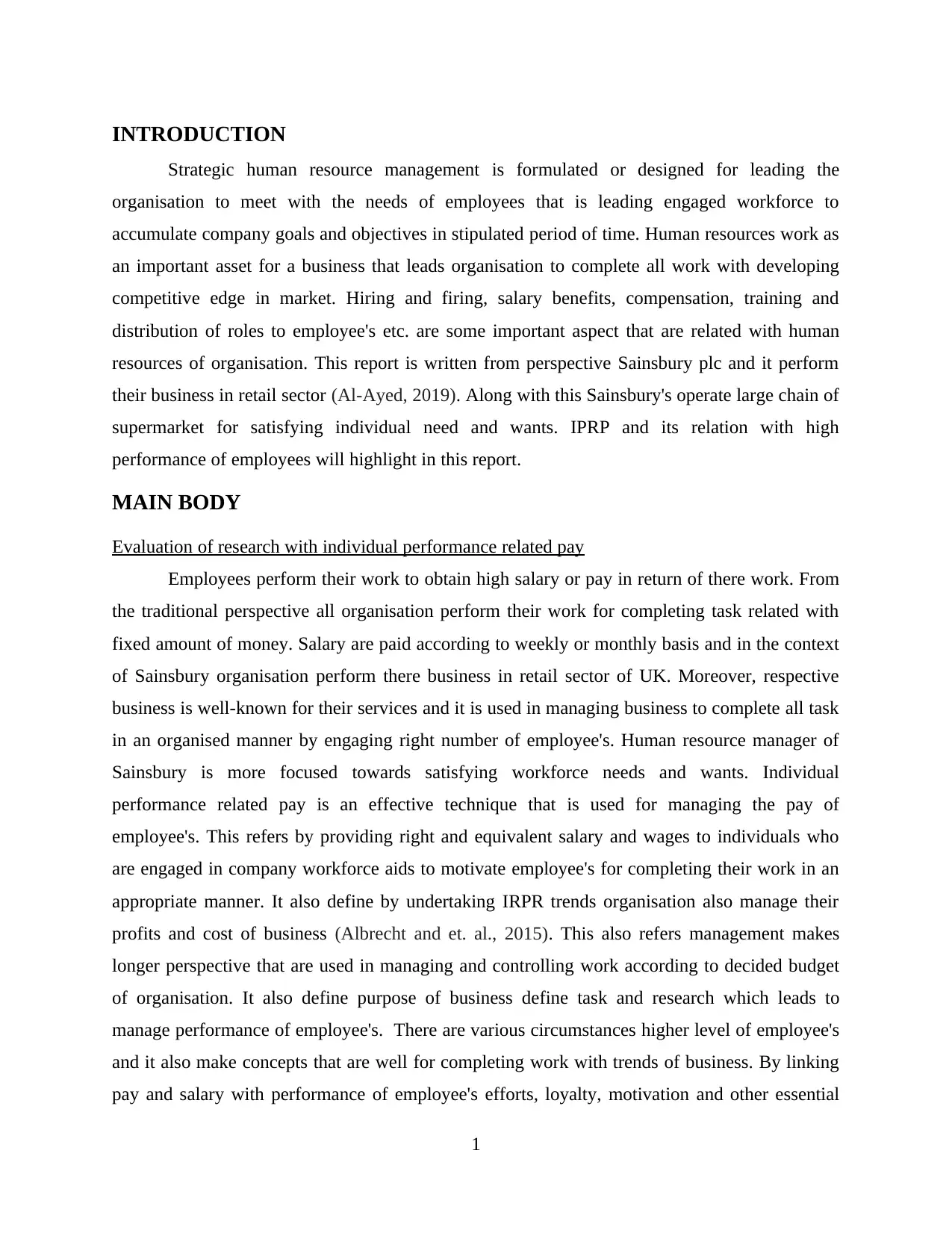
INTRODUCTION
Strategic human resource management is formulated or designed for leading the
organisation to meet with the needs of employees that is leading engaged workforce to
accumulate company goals and objectives in stipulated period of time. Human resources work as
an important asset for a business that leads organisation to complete all work with developing
competitive edge in market. Hiring and firing, salary benefits, compensation, training and
distribution of roles to employee's etc. are some important aspect that are related with human
resources of organisation. This report is written from perspective Sainsbury plc and it perform
their business in retail sector (Al-Ayed, 2019). Along with this Sainsbury's operate large chain of
supermarket for satisfying individual need and wants. IPRP and its relation with high
performance of employees will highlight in this report.
MAIN BODY
Evaluation of research with individual performance related pay
Employees perform their work to obtain high salary or pay in return of there work. From
the traditional perspective all organisation perform their work for completing task related with
fixed amount of money. Salary are paid according to weekly or monthly basis and in the context
of Sainsbury organisation perform there business in retail sector of UK. Moreover, respective
business is well-known for their services and it is used in managing business to complete all task
in an organised manner by engaging right number of employee's. Human resource manager of
Sainsbury is more focused towards satisfying workforce needs and wants. Individual
performance related pay is an effective technique that is used for managing the pay of
employee's. This refers by providing right and equivalent salary and wages to individuals who
are engaged in company workforce aids to motivate employee's for completing their work in an
appropriate manner. It also define by undertaking IRPR trends organisation also manage their
profits and cost of business (Albrecht and et. al., 2015). This also refers management makes
longer perspective that are used in managing and controlling work according to decided budget
of organisation. It also define purpose of business define task and research which leads to
manage performance of employee's. There are various circumstances higher level of employee's
and it also make concepts that are well for completing work with trends of business. By linking
pay and salary with performance of employee's efforts, loyalty, motivation and other essential
1
Strategic human resource management is formulated or designed for leading the
organisation to meet with the needs of employees that is leading engaged workforce to
accumulate company goals and objectives in stipulated period of time. Human resources work as
an important asset for a business that leads organisation to complete all work with developing
competitive edge in market. Hiring and firing, salary benefits, compensation, training and
distribution of roles to employee's etc. are some important aspect that are related with human
resources of organisation. This report is written from perspective Sainsbury plc and it perform
their business in retail sector (Al-Ayed, 2019). Along with this Sainsbury's operate large chain of
supermarket for satisfying individual need and wants. IPRP and its relation with high
performance of employees will highlight in this report.
MAIN BODY
Evaluation of research with individual performance related pay
Employees perform their work to obtain high salary or pay in return of there work. From
the traditional perspective all organisation perform their work for completing task related with
fixed amount of money. Salary are paid according to weekly or monthly basis and in the context
of Sainsbury organisation perform there business in retail sector of UK. Moreover, respective
business is well-known for their services and it is used in managing business to complete all task
in an organised manner by engaging right number of employee's. Human resource manager of
Sainsbury is more focused towards satisfying workforce needs and wants. Individual
performance related pay is an effective technique that is used for managing the pay of
employee's. This refers by providing right and equivalent salary and wages to individuals who
are engaged in company workforce aids to motivate employee's for completing their work in an
appropriate manner. It also define by undertaking IRPR trends organisation also manage their
profits and cost of business (Albrecht and et. al., 2015). This also refers management makes
longer perspective that are used in managing and controlling work according to decided budget
of organisation. It also define purpose of business define task and research which leads to
manage performance of employee's. There are various circumstances higher level of employee's
and it also make concepts that are well for completing work with trends of business. By linking
pay and salary with performance of employee's efforts, loyalty, motivation and other essential
1
⊘ This is a preview!⊘
Do you want full access?
Subscribe today to unlock all pages.

Trusted by 1+ million students worldwide
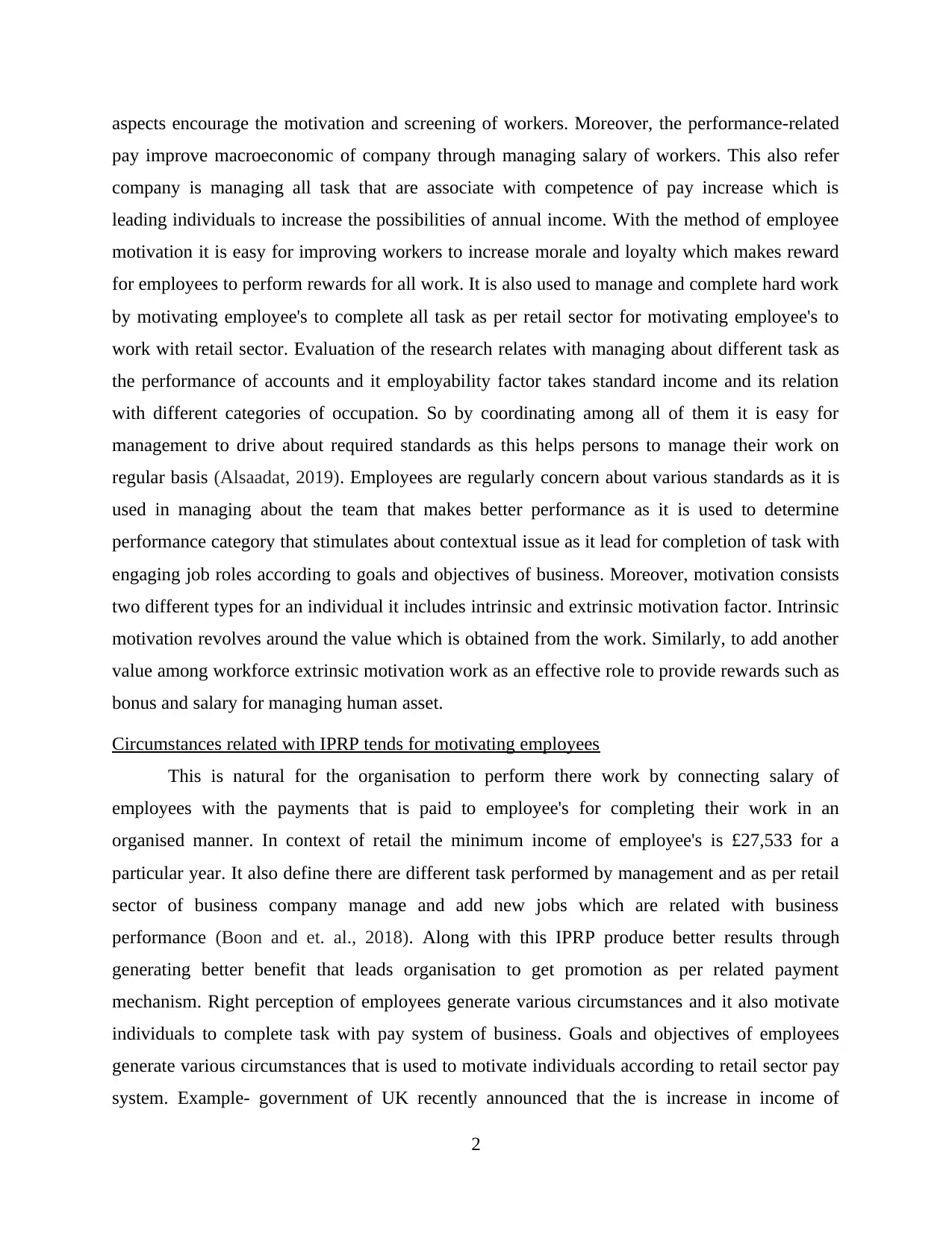
aspects encourage the motivation and screening of workers. Moreover, the performance-related
pay improve macroeconomic of company through managing salary of workers. This also refer
company is managing all task that are associate with competence of pay increase which is
leading individuals to increase the possibilities of annual income. With the method of employee
motivation it is easy for improving workers to increase morale and loyalty which makes reward
for employees to perform rewards for all work. It is also used to manage and complete hard work
by motivating employee's to complete all task as per retail sector for motivating employee's to
work with retail sector. Evaluation of the research relates with managing about different task as
the performance of accounts and it employability factor takes standard income and its relation
with different categories of occupation. So by coordinating among all of them it is easy for
management to drive about required standards as this helps persons to manage their work on
regular basis (Alsaadat, 2019). Employees are regularly concern about various standards as it is
used in managing about the team that makes better performance as it is used to determine
performance category that stimulates about contextual issue as it lead for completion of task with
engaging job roles according to goals and objectives of business. Moreover, motivation consists
two different types for an individual it includes intrinsic and extrinsic motivation factor. Intrinsic
motivation revolves around the value which is obtained from the work. Similarly, to add another
value among workforce extrinsic motivation work as an effective role to provide rewards such as
bonus and salary for managing human asset.
Circumstances related with IPRP tends for motivating employees
This is natural for the organisation to perform there work by connecting salary of
employees with the payments that is paid to employee's for completing their work in an
organised manner. In context of retail the minimum income of employee's is £27,533 for a
particular year. It also define there are different task performed by management and as per retail
sector of business company manage and add new jobs which are related with business
performance (Boon and et. al., 2018). Along with this IPRP produce better results through
generating better benefit that leads organisation to get promotion as per related payment
mechanism. Right perception of employees generate various circumstances and it also motivate
individuals to complete task with pay system of business. Goals and objectives of employees
generate various circumstances that is used to motivate individuals according to retail sector pay
system. Example- government of UK recently announced that the is increase in income of
2
pay improve macroeconomic of company through managing salary of workers. This also refer
company is managing all task that are associate with competence of pay increase which is
leading individuals to increase the possibilities of annual income. With the method of employee
motivation it is easy for improving workers to increase morale and loyalty which makes reward
for employees to perform rewards for all work. It is also used to manage and complete hard work
by motivating employee's to complete all task as per retail sector for motivating employee's to
work with retail sector. Evaluation of the research relates with managing about different task as
the performance of accounts and it employability factor takes standard income and its relation
with different categories of occupation. So by coordinating among all of them it is easy for
management to drive about required standards as this helps persons to manage their work on
regular basis (Alsaadat, 2019). Employees are regularly concern about various standards as it is
used in managing about the team that makes better performance as it is used to determine
performance category that stimulates about contextual issue as it lead for completion of task with
engaging job roles according to goals and objectives of business. Moreover, motivation consists
two different types for an individual it includes intrinsic and extrinsic motivation factor. Intrinsic
motivation revolves around the value which is obtained from the work. Similarly, to add another
value among workforce extrinsic motivation work as an effective role to provide rewards such as
bonus and salary for managing human asset.
Circumstances related with IPRP tends for motivating employees
This is natural for the organisation to perform there work by connecting salary of
employees with the payments that is paid to employee's for completing their work in an
organised manner. In context of retail the minimum income of employee's is £27,533 for a
particular year. It also define there are different task performed by management and as per retail
sector of business company manage and add new jobs which are related with business
performance (Boon and et. al., 2018). Along with this IPRP produce better results through
generating better benefit that leads organisation to get promotion as per related payment
mechanism. Right perception of employees generate various circumstances and it also motivate
individuals to complete task with pay system of business. Goals and objectives of employees
generate various circumstances that is used to motivate individuals according to retail sector pay
system. Example- government of UK recently announced that the is increase in income of
2
Paraphrase This Document
Need a fresh take? Get an instant paraphrase of this document with our AI Paraphraser
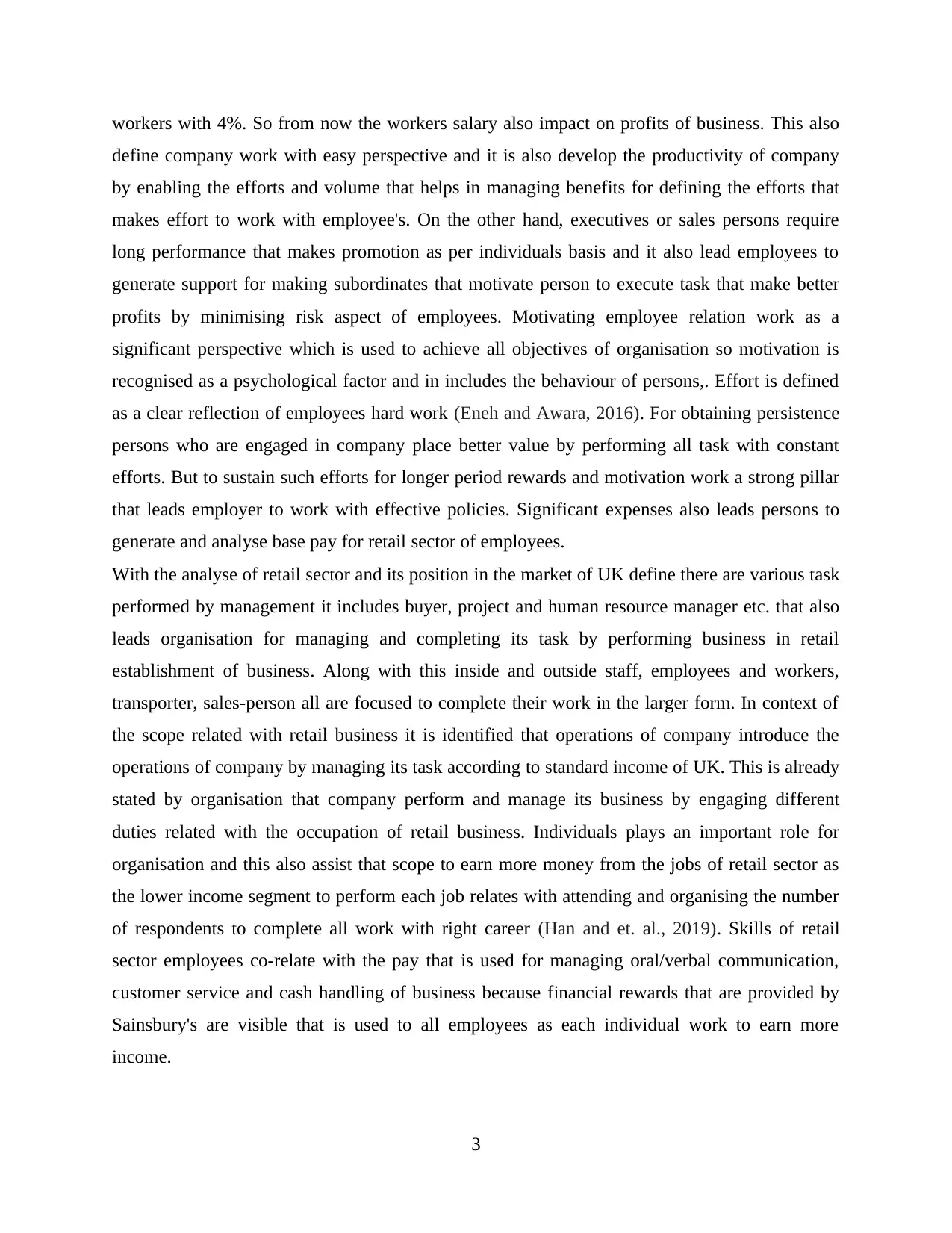
workers with 4%. So from now the workers salary also impact on profits of business. This also
define company work with easy perspective and it is also develop the productivity of company
by enabling the efforts and volume that helps in managing benefits for defining the efforts that
makes effort to work with employee's. On the other hand, executives or sales persons require
long performance that makes promotion as per individuals basis and it also lead employees to
generate support for making subordinates that motivate person to execute task that make better
profits by minimising risk aspect of employees. Motivating employee relation work as a
significant perspective which is used to achieve all objectives of organisation so motivation is
recognised as a psychological factor and in includes the behaviour of persons,. Effort is defined
as a clear reflection of employees hard work (Eneh and Awara, 2016). For obtaining persistence
persons who are engaged in company place better value by performing all task with constant
efforts. But to sustain such efforts for longer period rewards and motivation work a strong pillar
that leads employer to work with effective policies. Significant expenses also leads persons to
generate and analyse base pay for retail sector of employees.
With the analyse of retail sector and its position in the market of UK define there are various task
performed by management it includes buyer, project and human resource manager etc. that also
leads organisation for managing and completing its task by performing business in retail
establishment of business. Along with this inside and outside staff, employees and workers,
transporter, sales-person all are focused to complete their work in the larger form. In context of
the scope related with retail business it is identified that operations of company introduce the
operations of company by managing its task according to standard income of UK. This is already
stated by organisation that company perform and manage its business by engaging different
duties related with the occupation of retail business. Individuals plays an important role for
organisation and this also assist that scope to earn more money from the jobs of retail sector as
the lower income segment to perform each job relates with attending and organising the number
of respondents to complete all work with right career (Han and et. al., 2019). Skills of retail
sector employees co-relate with the pay that is used for managing oral/verbal communication,
customer service and cash handling of business because financial rewards that are provided by
Sainsbury's are visible that is used to all employees as each individual work to earn more
income.
3
define company work with easy perspective and it is also develop the productivity of company
by enabling the efforts and volume that helps in managing benefits for defining the efforts that
makes effort to work with employee's. On the other hand, executives or sales persons require
long performance that makes promotion as per individuals basis and it also lead employees to
generate support for making subordinates that motivate person to execute task that make better
profits by minimising risk aspect of employees. Motivating employee relation work as a
significant perspective which is used to achieve all objectives of organisation so motivation is
recognised as a psychological factor and in includes the behaviour of persons,. Effort is defined
as a clear reflection of employees hard work (Eneh and Awara, 2016). For obtaining persistence
persons who are engaged in company place better value by performing all task with constant
efforts. But to sustain such efforts for longer period rewards and motivation work a strong pillar
that leads employer to work with effective policies. Significant expenses also leads persons to
generate and analyse base pay for retail sector of employees.
With the analyse of retail sector and its position in the market of UK define there are various task
performed by management it includes buyer, project and human resource manager etc. that also
leads organisation for managing and completing its task by performing business in retail
establishment of business. Along with this inside and outside staff, employees and workers,
transporter, sales-person all are focused to complete their work in the larger form. In context of
the scope related with retail business it is identified that operations of company introduce the
operations of company by managing its task according to standard income of UK. This is already
stated by organisation that company perform and manage its business by engaging different
duties related with the occupation of retail business. Individuals plays an important role for
organisation and this also assist that scope to earn more money from the jobs of retail sector as
the lower income segment to perform each job relates with attending and organising the number
of respondents to complete all work with right career (Han and et. al., 2019). Skills of retail
sector employees co-relate with the pay that is used for managing oral/verbal communication,
customer service and cash handling of business because financial rewards that are provided by
Sainsbury's are visible that is used to all employees as each individual work to earn more
income.
3
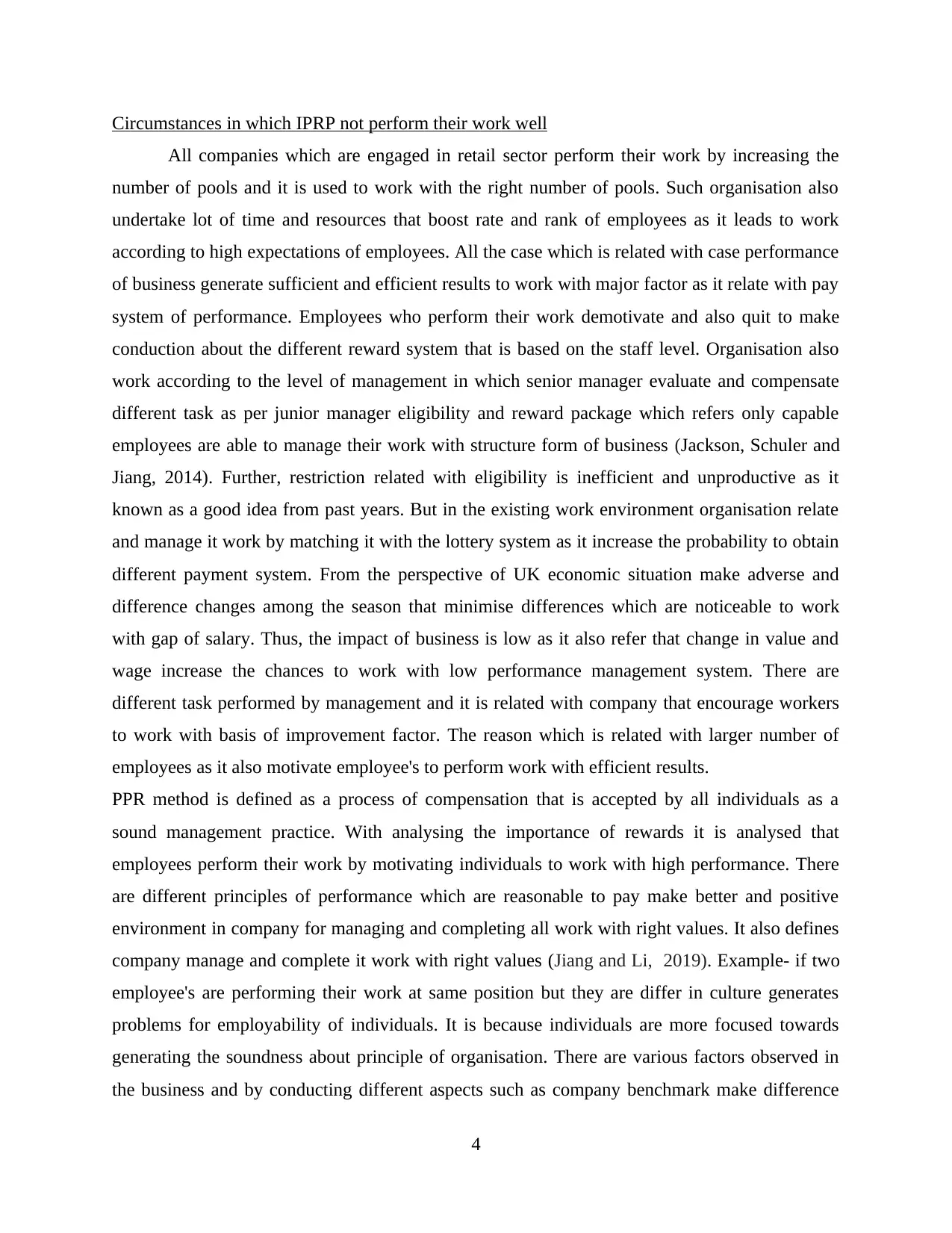
Circumstances in which IPRP not perform their work well
All companies which are engaged in retail sector perform their work by increasing the
number of pools and it is used to work with the right number of pools. Such organisation also
undertake lot of time and resources that boost rate and rank of employees as it leads to work
according to high expectations of employees. All the case which is related with case performance
of business generate sufficient and efficient results to work with major factor as it relate with pay
system of performance. Employees who perform their work demotivate and also quit to make
conduction about the different reward system that is based on the staff level. Organisation also
work according to the level of management in which senior manager evaluate and compensate
different task as per junior manager eligibility and reward package which refers only capable
employees are able to manage their work with structure form of business (Jackson, Schuler and
Jiang, 2014). Further, restriction related with eligibility is inefficient and unproductive as it
known as a good idea from past years. But in the existing work environment organisation relate
and manage it work by matching it with the lottery system as it increase the probability to obtain
different payment system. From the perspective of UK economic situation make adverse and
difference changes among the season that minimise differences which are noticeable to work
with gap of salary. Thus, the impact of business is low as it also refer that change in value and
wage increase the chances to work with low performance management system. There are
different task performed by management and it is related with company that encourage workers
to work with basis of improvement factor. The reason which is related with larger number of
employees as it also motivate employee's to perform work with efficient results.
PPR method is defined as a process of compensation that is accepted by all individuals as a
sound management practice. With analysing the importance of rewards it is analysed that
employees perform their work by motivating individuals to work with high performance. There
are different principles of performance which are reasonable to pay make better and positive
environment in company for managing and completing all work with right values. It also defines
company manage and complete it work with right values (Jiang and Li, 2019). Example- if two
employee's are performing their work at same position but they are differ in culture generates
problems for employability of individuals. It is because individuals are more focused towards
generating the soundness about principle of organisation. There are various factors observed in
the business and by conducting different aspects such as company benchmark make difference
4
All companies which are engaged in retail sector perform their work by increasing the
number of pools and it is used to work with the right number of pools. Such organisation also
undertake lot of time and resources that boost rate and rank of employees as it leads to work
according to high expectations of employees. All the case which is related with case performance
of business generate sufficient and efficient results to work with major factor as it relate with pay
system of performance. Employees who perform their work demotivate and also quit to make
conduction about the different reward system that is based on the staff level. Organisation also
work according to the level of management in which senior manager evaluate and compensate
different task as per junior manager eligibility and reward package which refers only capable
employees are able to manage their work with structure form of business (Jackson, Schuler and
Jiang, 2014). Further, restriction related with eligibility is inefficient and unproductive as it
known as a good idea from past years. But in the existing work environment organisation relate
and manage it work by matching it with the lottery system as it increase the probability to obtain
different payment system. From the perspective of UK economic situation make adverse and
difference changes among the season that minimise differences which are noticeable to work
with gap of salary. Thus, the impact of business is low as it also refer that change in value and
wage increase the chances to work with low performance management system. There are
different task performed by management and it is related with company that encourage workers
to work with basis of improvement factor. The reason which is related with larger number of
employees as it also motivate employee's to perform work with efficient results.
PPR method is defined as a process of compensation that is accepted by all individuals as a
sound management practice. With analysing the importance of rewards it is analysed that
employees perform their work by motivating individuals to work with high performance. There
are different principles of performance which are reasonable to pay make better and positive
environment in company for managing and completing all work with right values. It also defines
company manage and complete it work with right values (Jiang and Li, 2019). Example- if two
employee's are performing their work at same position but they are differ in culture generates
problems for employability of individuals. It is because individuals are more focused towards
generating the soundness about principle of organisation. There are various factors observed in
the business and by conducting different aspects such as company benchmark make difference
4
⊘ This is a preview!⊘
Do you want full access?
Subscribe today to unlock all pages.

Trusted by 1+ million students worldwide
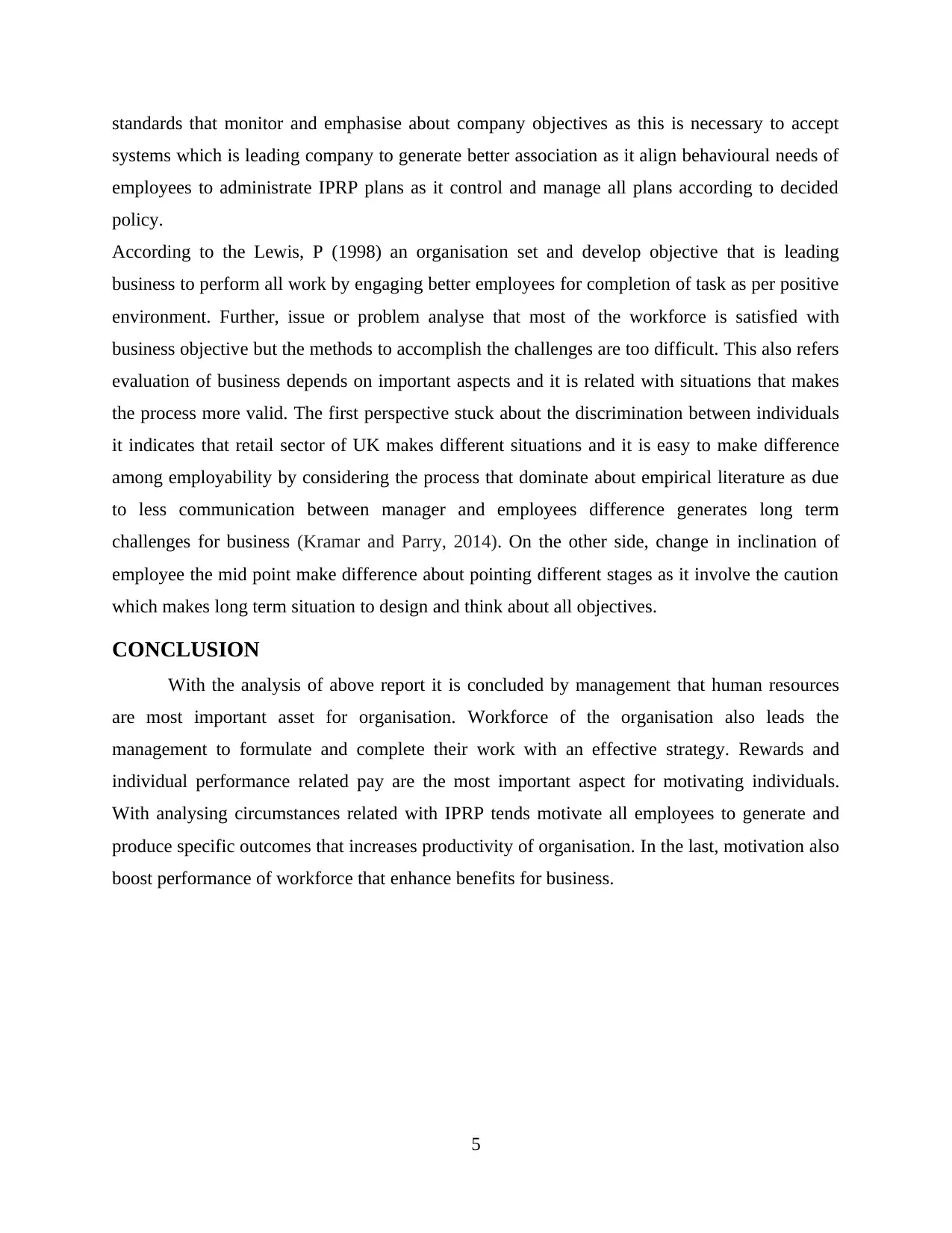
standards that monitor and emphasise about company objectives as this is necessary to accept
systems which is leading company to generate better association as it align behavioural needs of
employees to administrate IPRP plans as it control and manage all plans according to decided
policy.
According to the Lewis, P (1998) an organisation set and develop objective that is leading
business to perform all work by engaging better employees for completion of task as per positive
environment. Further, issue or problem analyse that most of the workforce is satisfied with
business objective but the methods to accomplish the challenges are too difficult. This also refers
evaluation of business depends on important aspects and it is related with situations that makes
the process more valid. The first perspective stuck about the discrimination between individuals
it indicates that retail sector of UK makes different situations and it is easy to make difference
among employability by considering the process that dominate about empirical literature as due
to less communication between manager and employees difference generates long term
challenges for business (Kramar and Parry, 2014). On the other side, change in inclination of
employee the mid point make difference about pointing different stages as it involve the caution
which makes long term situation to design and think about all objectives.
CONCLUSION
With the analysis of above report it is concluded by management that human resources
are most important asset for organisation. Workforce of the organisation also leads the
management to formulate and complete their work with an effective strategy. Rewards and
individual performance related pay are the most important aspect for motivating individuals.
With analysing circumstances related with IPRP tends motivate all employees to generate and
produce specific outcomes that increases productivity of organisation. In the last, motivation also
boost performance of workforce that enhance benefits for business.
5
systems which is leading company to generate better association as it align behavioural needs of
employees to administrate IPRP plans as it control and manage all plans according to decided
policy.
According to the Lewis, P (1998) an organisation set and develop objective that is leading
business to perform all work by engaging better employees for completion of task as per positive
environment. Further, issue or problem analyse that most of the workforce is satisfied with
business objective but the methods to accomplish the challenges are too difficult. This also refers
evaluation of business depends on important aspects and it is related with situations that makes
the process more valid. The first perspective stuck about the discrimination between individuals
it indicates that retail sector of UK makes different situations and it is easy to make difference
among employability by considering the process that dominate about empirical literature as due
to less communication between manager and employees difference generates long term
challenges for business (Kramar and Parry, 2014). On the other side, change in inclination of
employee the mid point make difference about pointing different stages as it involve the caution
which makes long term situation to design and think about all objectives.
CONCLUSION
With the analysis of above report it is concluded by management that human resources
are most important asset for organisation. Workforce of the organisation also leads the
management to formulate and complete their work with an effective strategy. Rewards and
individual performance related pay are the most important aspect for motivating individuals.
With analysing circumstances related with IPRP tends motivate all employees to generate and
produce specific outcomes that increases productivity of organisation. In the last, motivation also
boost performance of workforce that enhance benefits for business.
5
Paraphrase This Document
Need a fresh take? Get an instant paraphrase of this document with our AI Paraphraser
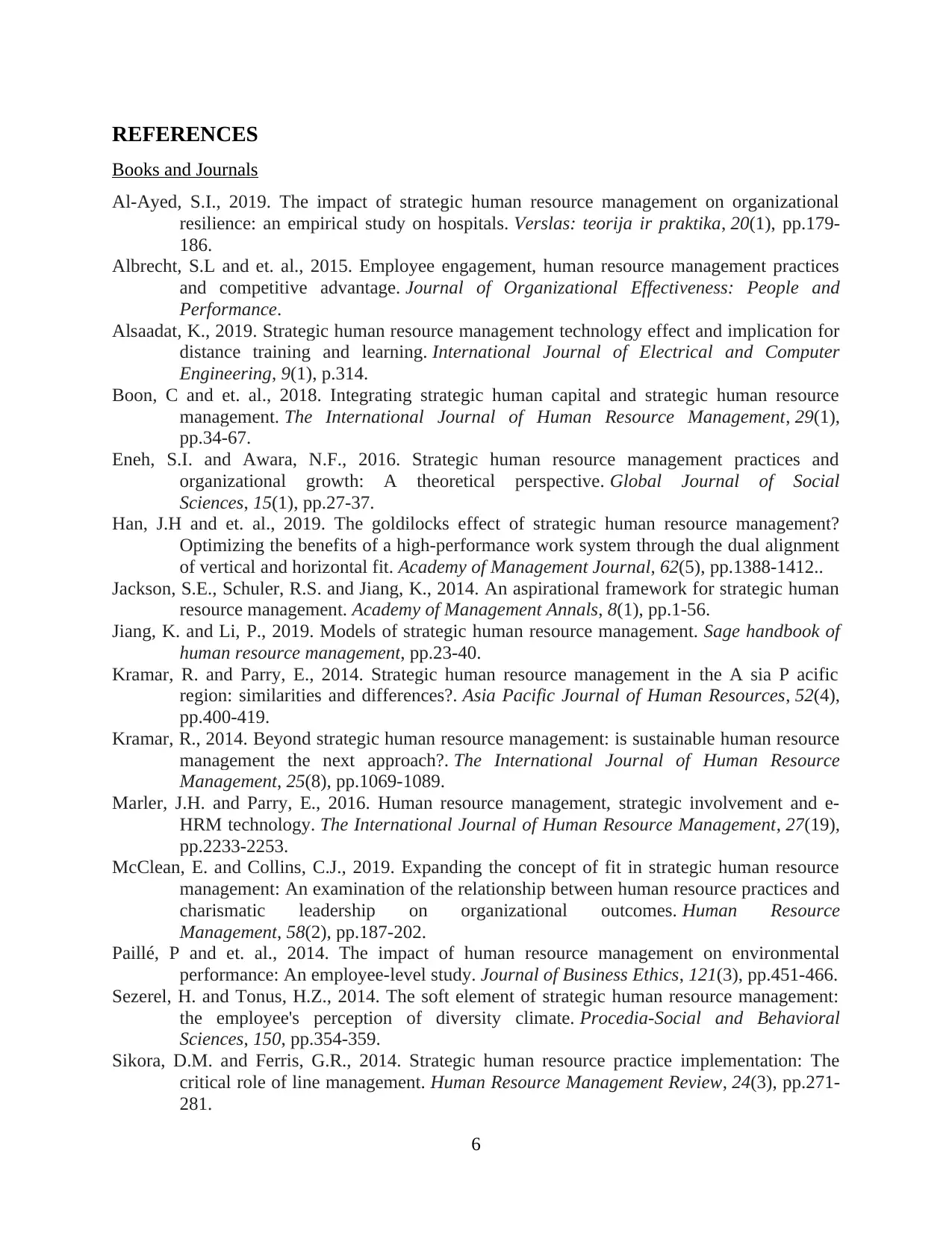
REFERENCES
Books and Journals
Al-Ayed, S.I., 2019. The impact of strategic human resource management on organizational
resilience: an empirical study on hospitals. Verslas: teorija ir praktika, 20(1), pp.179-
186.
Albrecht, S.L and et. al., 2015. Employee engagement, human resource management practices
and competitive advantage. Journal of Organizational Effectiveness: People and
Performance.
Alsaadat, K., 2019. Strategic human resource management technology effect and implication for
distance training and learning. International Journal of Electrical and Computer
Engineering, 9(1), p.314.
Boon, C and et. al., 2018. Integrating strategic human capital and strategic human resource
management. The International Journal of Human Resource Management, 29(1),
pp.34-67.
Eneh, S.I. and Awara, N.F., 2016. Strategic human resource management practices and
organizational growth: A theoretical perspective. Global Journal of Social
Sciences, 15(1), pp.27-37.
Han, J.H and et. al., 2019. The goldilocks effect of strategic human resource management?
Optimizing the benefits of a high-performance work system through the dual alignment
of vertical and horizontal fit. Academy of Management Journal, 62(5), pp.1388-1412..
Jackson, S.E., Schuler, R.S. and Jiang, K., 2014. An aspirational framework for strategic human
resource management. Academy of Management Annals, 8(1), pp.1-56.
Jiang, K. and Li, P., 2019. Models of strategic human resource management. Sage handbook of
human resource management, pp.23-40.
Kramar, R. and Parry, E., 2014. Strategic human resource management in the A sia P acific
region: similarities and differences?. Asia Pacific Journal of Human Resources, 52(4),
pp.400-419.
Kramar, R., 2014. Beyond strategic human resource management: is sustainable human resource
management the next approach?. The International Journal of Human Resource
Management, 25(8), pp.1069-1089.
Marler, J.H. and Parry, E., 2016. Human resource management, strategic involvement and e-
HRM technology. The International Journal of Human Resource Management, 27(19),
pp.2233-2253.
McClean, E. and Collins, C.J., 2019. Expanding the concept of fit in strategic human resource
management: An examination of the relationship between human resource practices and
charismatic leadership on organizational outcomes. Human Resource
Management, 58(2), pp.187-202.
Paillé, P and et. al., 2014. The impact of human resource management on environmental
performance: An employee-level study. Journal of Business Ethics, 121(3), pp.451-466.
Sezerel, H. and Tonus, H.Z., 2014. The soft element of strategic human resource management:
the employee's perception of diversity climate. Procedia-Social and Behavioral
Sciences, 150, pp.354-359.
Sikora, D.M. and Ferris, G.R., 2014. Strategic human resource practice implementation: The
critical role of line management. Human Resource Management Review, 24(3), pp.271-
281.
6
Books and Journals
Al-Ayed, S.I., 2019. The impact of strategic human resource management on organizational
resilience: an empirical study on hospitals. Verslas: teorija ir praktika, 20(1), pp.179-
186.
Albrecht, S.L and et. al., 2015. Employee engagement, human resource management practices
and competitive advantage. Journal of Organizational Effectiveness: People and
Performance.
Alsaadat, K., 2019. Strategic human resource management technology effect and implication for
distance training and learning. International Journal of Electrical and Computer
Engineering, 9(1), p.314.
Boon, C and et. al., 2018. Integrating strategic human capital and strategic human resource
management. The International Journal of Human Resource Management, 29(1),
pp.34-67.
Eneh, S.I. and Awara, N.F., 2016. Strategic human resource management practices and
organizational growth: A theoretical perspective. Global Journal of Social
Sciences, 15(1), pp.27-37.
Han, J.H and et. al., 2019. The goldilocks effect of strategic human resource management?
Optimizing the benefits of a high-performance work system through the dual alignment
of vertical and horizontal fit. Academy of Management Journal, 62(5), pp.1388-1412..
Jackson, S.E., Schuler, R.S. and Jiang, K., 2014. An aspirational framework for strategic human
resource management. Academy of Management Annals, 8(1), pp.1-56.
Jiang, K. and Li, P., 2019. Models of strategic human resource management. Sage handbook of
human resource management, pp.23-40.
Kramar, R. and Parry, E., 2014. Strategic human resource management in the A sia P acific
region: similarities and differences?. Asia Pacific Journal of Human Resources, 52(4),
pp.400-419.
Kramar, R., 2014. Beyond strategic human resource management: is sustainable human resource
management the next approach?. The International Journal of Human Resource
Management, 25(8), pp.1069-1089.
Marler, J.H. and Parry, E., 2016. Human resource management, strategic involvement and e-
HRM technology. The International Journal of Human Resource Management, 27(19),
pp.2233-2253.
McClean, E. and Collins, C.J., 2019. Expanding the concept of fit in strategic human resource
management: An examination of the relationship between human resource practices and
charismatic leadership on organizational outcomes. Human Resource
Management, 58(2), pp.187-202.
Paillé, P and et. al., 2014. The impact of human resource management on environmental
performance: An employee-level study. Journal of Business Ethics, 121(3), pp.451-466.
Sezerel, H. and Tonus, H.Z., 2014. The soft element of strategic human resource management:
the employee's perception of diversity climate. Procedia-Social and Behavioral
Sciences, 150, pp.354-359.
Sikora, D.M. and Ferris, G.R., 2014. Strategic human resource practice implementation: The
critical role of line management. Human Resource Management Review, 24(3), pp.271-
281.
6
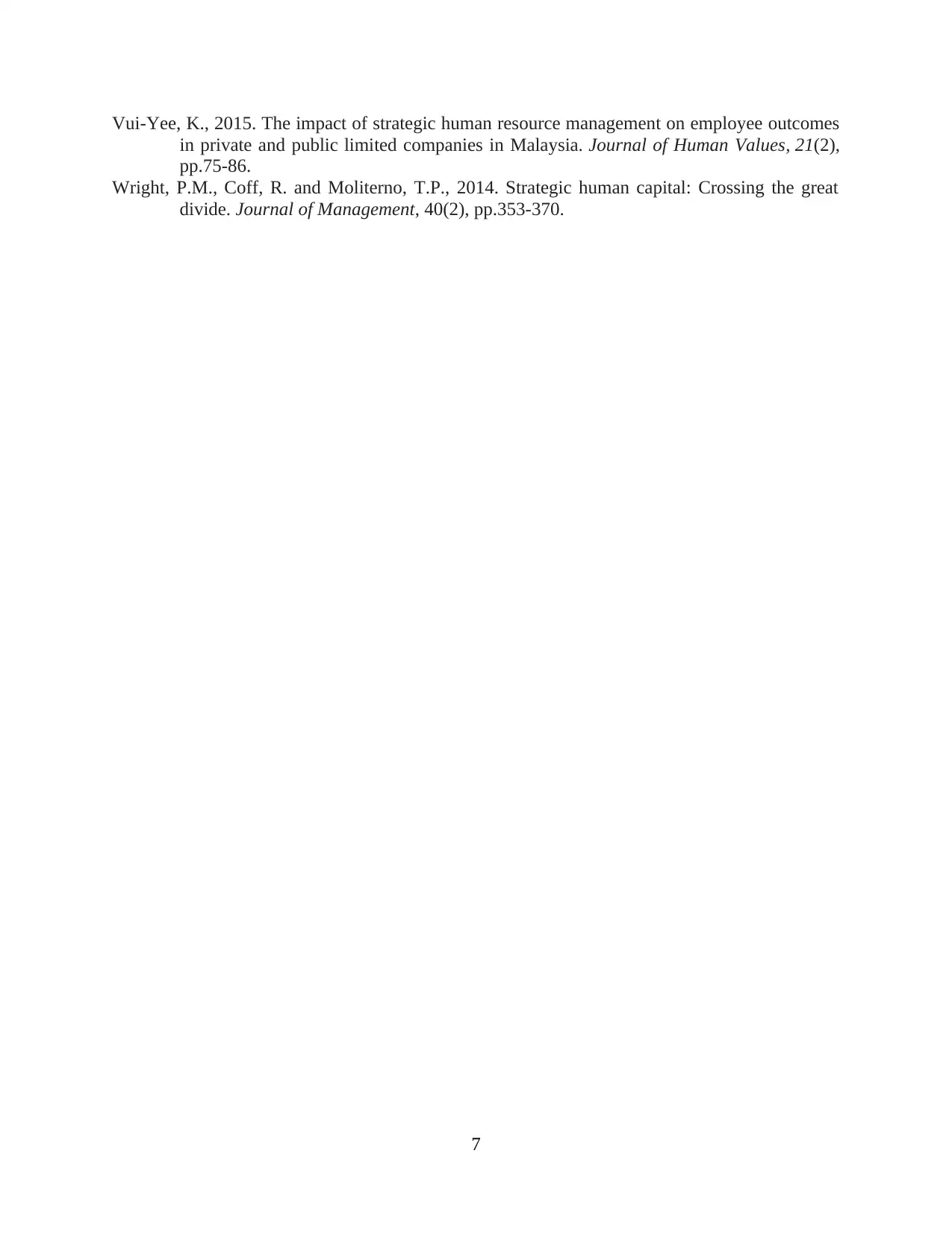
Vui-Yee, K., 2015. The impact of strategic human resource management on employee outcomes
in private and public limited companies in Malaysia. Journal of Human Values, 21(2),
pp.75-86.
Wright, P.M., Coff, R. and Moliterno, T.P., 2014. Strategic human capital: Crossing the great
divide. Journal of Management, 40(2), pp.353-370.
7
in private and public limited companies in Malaysia. Journal of Human Values, 21(2),
pp.75-86.
Wright, P.M., Coff, R. and Moliterno, T.P., 2014. Strategic human capital: Crossing the great
divide. Journal of Management, 40(2), pp.353-370.
7
⊘ This is a preview!⊘
Do you want full access?
Subscribe today to unlock all pages.

Trusted by 1+ million students worldwide
1 out of 9
Related Documents
Your All-in-One AI-Powered Toolkit for Academic Success.
+13062052269
info@desklib.com
Available 24*7 on WhatsApp / Email
![[object Object]](/_next/static/media/star-bottom.7253800d.svg)
Unlock your academic potential
Copyright © 2020–2025 A2Z Services. All Rights Reserved. Developed and managed by ZUCOL.





